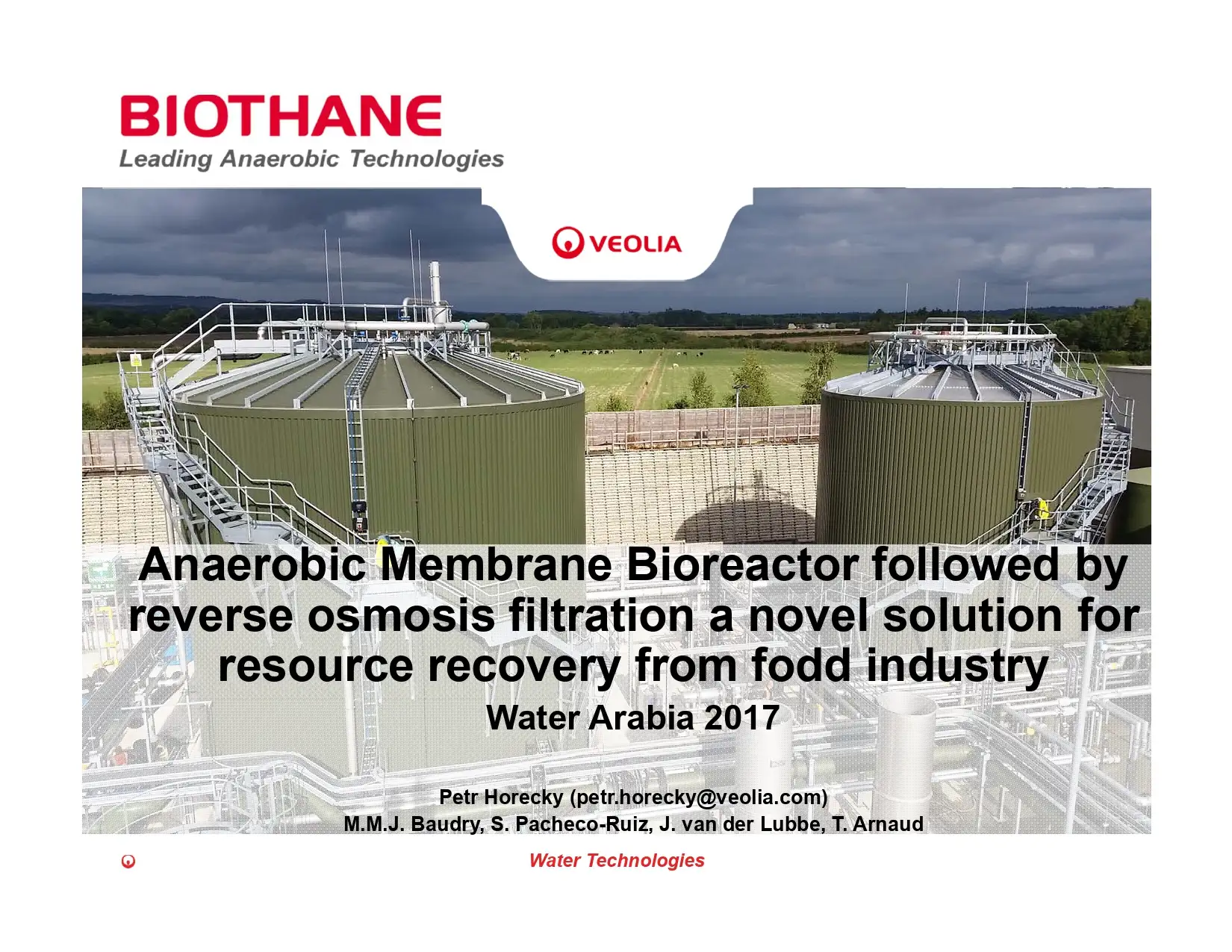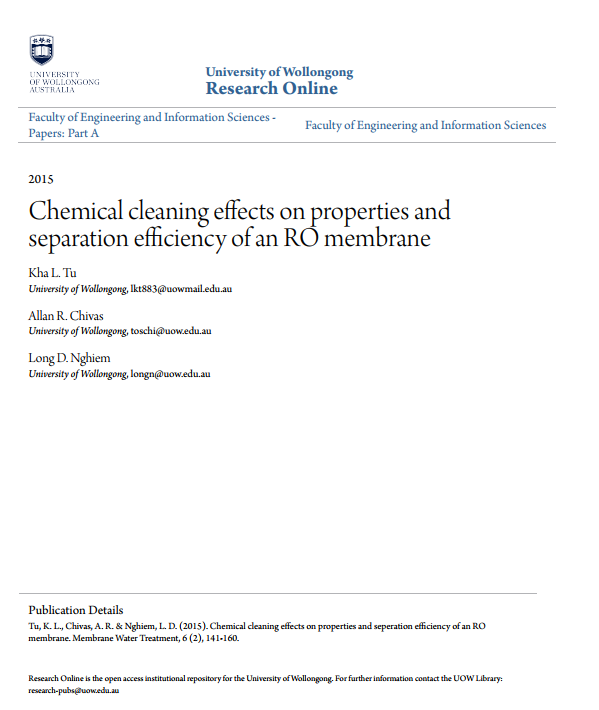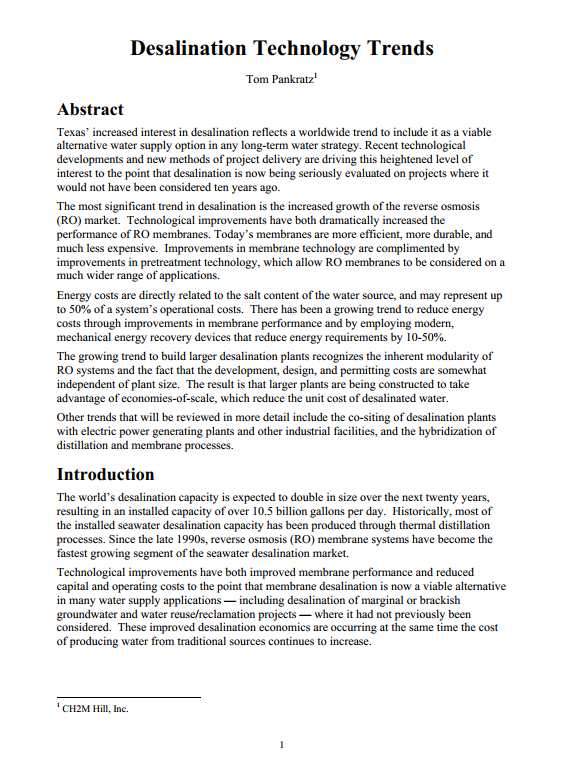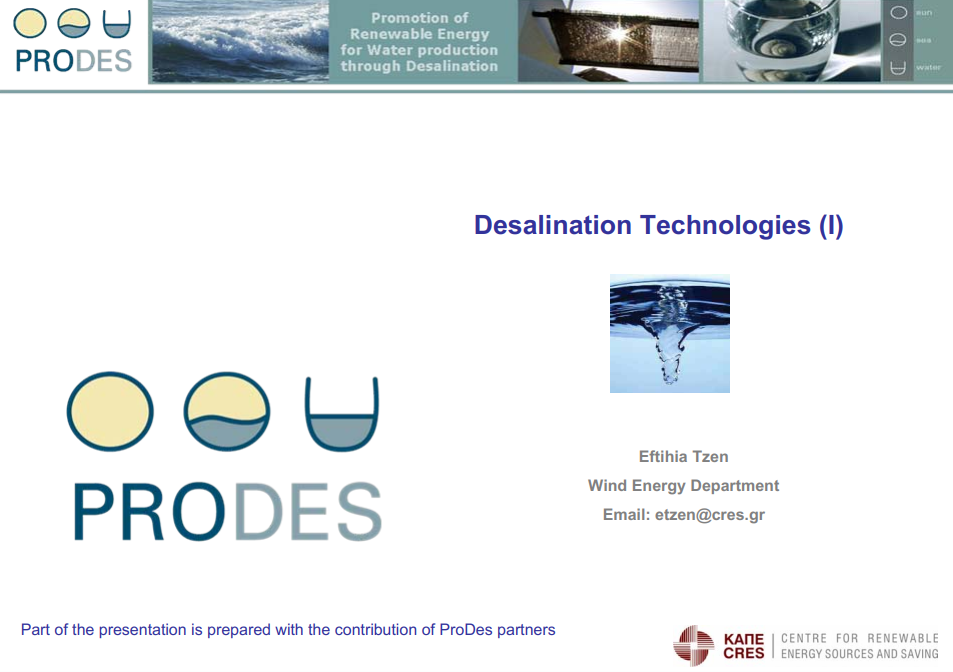Desalination Of High Salinity Produced Waters And Brines
DESALINATION OF HIGH SALINITY PRODUCED WATERS AND BRINES
Credit to: https://cese.utulsa.edu/
Jinesh Jain, Jason Arena, Alexandra Hakala, and Nicholas Siefert
1USUS-DOE National Energy Technology Laboratory, Pittsburgh, PAPA
2AECOM, Pittsburgh, PA, PA
Usually dispatched in 2 to 3 days
Usually dispatched in 2 to 3 days
Category:
Water Desalination & RO
Only logged in customers who have purchased this product may leave a review.
Related products
Chemical Cleaning Effects On Properties And Separation Efciency Of An RO Membrane
Abstract: This study aims to investigate the impacts of chemical cleaning on the performance of a reverse osmosis
membrane. Chemicals used for simulating membrane cleaning include a surfactant (sodium dodecyl sulfate, SDS), a
chelating agent (ethylenediaminetetraacetic acid, EDTA), and two proprietary cleaning formulations namely MC3
and MC11. The impact of sequential exposure to multiple membrane cleaning solutions was also examined. Water
permeability and the rejection of boron and sodium were investigated under various water fluxes, temperatures and
feedwater pH. Changes in the membrane performance were systematically explained based on the changes in the
charge density, hydrophobicity and chemical structure of the membrane surface. The experimental results show that
membrane cleaning can significantly alter the hydrophobicity and water permeability of the membrane; however, its
impacts on the rejections of boron and sodium are marginal. Although the presence of surfactant or chelating agent
may cause decreases in the rejection, solution pH is the key factor responsible for the loss of membrane separation
and changes in the surface properties. The impact of solution pH on the water permeability can be reversed by
applying a subsequent cleaning with the opposite pH condition. Nevertheless, the impacts of solution pH on boron
and sodium rejections are irreversible in most cases
Chemical Cleaning Effects On Properties And Separation Efciency Of An RO Membrane
Abstract: This study aims to investigate the impacts of chemical cleaning on the performance of a reverse osmosis
membrane. Chemicals used for simulating membrane cleaning include a surfactant (sodium dodecyl sulfate, SDS), a
chelating agent (ethylenediaminetetraacetic acid, EDTA), and two proprietary cleaning formulations namely MC3
and MC11. The impact of sequential exposure to multiple membrane cleaning solutions was also examined. Water
permeability and the rejection of boron and sodium were investigated under various water fluxes, temperatures and
feedwater pH. Changes in the membrane performance were systematically explained based on the changes in the
charge density, hydrophobicity and chemical structure of the membrane surface. The experimental results show that
membrane cleaning can significantly alter the hydrophobicity and water permeability of the membrane; however, its
impacts on the rejections of boron and sodium are marginal. Although the presence of surfactant or chelating agent
may cause decreases in the rejection, solution pH is the key factor responsible for the loss of membrane separation
and changes in the surface properties. The impact of solution pH on the water permeability can be reversed by
applying a subsequent cleaning with the opposite pH condition. Nevertheless, the impacts of solution pH on boron
and sodium rejections are irreversible in most cases
Desalination Technology Trends
Abstract:
Texas’ increased interest in desalination reflects a worldwide trend to include it as a viable alternative water supply option in any long-term water strategy. Recent technological developments and new methods of project delivery are driving this heightened level of interest to the point that desalination is now being seriously evaluated on projects where it would not have been considered ten years ago. The most significant trend in desalination is the increased growth of the reverse osmosis(RO) market. Technological improvements have both dramatically increased the performance of RO membranes. Today’s membranes are more efficient, more durable, and much less expensive. Improvements in membrane technology are complimented by improvements in pretreatment technology, which allow RO membranes to be considered on a much wider range of applications. Energy costs are directly related to the salt content of the water source, and may represent up to 50% of a system’s operational costs. There has been a growing trend to reduce energy costs through improvements in membrane performance and by employing modern, mechanical energy recovery devices that reduce energy requirements by 10-50%. The growing trend to build larger desalination plants recognizes the inherent modularity of RO systems and the fact that the development, design, and permitting costs are somewhat independent of plant size. The result is that larger plants are being constructed to take advantage of economies-of-scale, which reduce the unit cost of desalinated water. Other trends that will be reviewed in more detail include the co-siting of desalination plants with electric power generating plants and other industrial facilities, and the hybridization of distillation and membrane processes.
Desalination Technology Trends
Abstract:
Texas’ increased interest in desalination reflects a worldwide trend to include it as a viable alternative water supply option in any long-term water strategy. Recent technological developments and new methods of project delivery are driving this heightened level of interest to the point that desalination is now being seriously evaluated on projects where it would not have been considered ten years ago. The most significant trend in desalination is the increased growth of the reverse osmosis(RO) market. Technological improvements have both dramatically increased the performance of RO membranes. Today’s membranes are more efficient, more durable, and much less expensive. Improvements in membrane technology are complimented by improvements in pretreatment technology, which allow RO membranes to be considered on a much wider range of applications. Energy costs are directly related to the salt content of the water source, and may represent up to 50% of a system’s operational costs. There has been a growing trend to reduce energy costs through improvements in membrane performance and by employing modern, mechanical energy recovery devices that reduce energy requirements by 10-50%. The growing trend to build larger desalination plants recognizes the inherent modularity of RO systems and the fact that the development, design, and permitting costs are somewhat independent of plant size. The result is that larger plants are being constructed to take advantage of economies-of-scale, which reduce the unit cost of desalinated water. Other trends that will be reviewed in more detail include the co-siting of desalination plants with electric power generating plants and other industrial facilities, and the hybridization of distillation and membrane processes.
A Primer On Brackish And Seawater Desalination
Abstract: This publication was produced as an activity of the Texas Living Waters Project. This project
is a collaborative effort of the National Wildlife Federation, Environmental Defense, and the Lone
Star Chapter of the Sierra Club. The goals of the project are to 1) ensure adequate water for people
and environmental needs, 2) reduce future demand for water and foster efficient and sustainable use
of current water supplies, 3) educate the public and decision makers about the impact of wasteful
water use and the opportunities for water conservation, and 4) involve citizens in the decision
making process for water management.
A Primer On Brackish And Seawater Desalination
Abstract: This publication was produced as an activity of the Texas Living Waters Project. This project
is a collaborative effort of the National Wildlife Federation, Environmental Defense, and the Lone
Star Chapter of the Sierra Club. The goals of the project are to 1) ensure adequate water for people
and environmental needs, 2) reduce future demand for water and foster efficient and sustainable use
of current water supplies, 3) educate the public and decision makers about the impact of wasteful
water use and the opportunities for water conservation, and 4) involve citizens in the decision
making process for water management.
Desalination Technology Trends And CH2M HILL
Presentation Outline:
- The Growing Desalination Market
- Trends in the Technology/Virtual expo
- Thermal Desalination
Desalination Technology Trends And CH2M HILL
Presentation Outline:
- The Growing Desalination Market
- Trends in the Technology/Virtual expo
- Thermal Desalination
Concentrating Solar Power For Seawater Desalination
Introduction:
The general perception of “solar desalination” today comprises only small scale technologies for decentralized water supply in remote places, which may be quite important for the development of rural areas, but do not address the increasing water deficits of the quickly growing urban centers of demand. Conventional large scale desalination is perceived as expensive, energy consuming and limited to rich countries like those of the Arabian Gulf, especially in view of the quickly escalating cost of fossil fuels like oil, natural gas and coal. The environmental impacts of large scale desalination due to airborne emissions of pollutants from energy consumption and to the discharge of brine and chemical additives to the sea are increasingly considered as critical. For those reasons, most contemporary strategies against a “Global Water Crisis” consider seawater desalination only as a marginal element of supply. The focus of most recommendations lies on more efficient use of water, better accountability, re-use of waste water, enhanced distribution and advanced irrigation systems. To this adds the recommendation to reduce agriculture and rather import food from other places. On the other hand, most sources that do recommend seawater desalination as part of a solution to the water crisis usually propose nuclear fission and fusion as indispensable option.
Concentrating Solar Power For Seawater Desalination
Introduction:
The general perception of “solar desalination” today comprises only small scale technologies for decentralized water supply in remote places, which may be quite important for the development of rural areas, but do not address the increasing water deficits of the quickly growing urban centers of demand. Conventional large scale desalination is perceived as expensive, energy consuming and limited to rich countries like those of the Arabian Gulf, especially in view of the quickly escalating cost of fossil fuels like oil, natural gas and coal. The environmental impacts of large scale desalination due to airborne emissions of pollutants from energy consumption and to the discharge of brine and chemical additives to the sea are increasingly considered as critical. For those reasons, most contemporary strategies against a “Global Water Crisis” consider seawater desalination only as a marginal element of supply. The focus of most recommendations lies on more efficient use of water, better accountability, re-use of waste water, enhanced distribution and advanced irrigation systems. To this adds the recommendation to reduce agriculture and rather import food from other places. On the other hand, most sources that do recommend seawater desalination as part of a solution to the water crisis usually propose nuclear fission and fusion as indispensable option.
Desalination as an Alternative to Alleviate Water Scarcity and a Climate Change Adaptation Option in the MENA Region
This report has been prepared by Dr. Jauad El Kharraz at MEDRC with the support of Eng. Ayisha Al-Hinaai, Eng. Riadh Dridi, Ms. Elsa Andrews, Ms. Jackie Allison, and Eng. Georges Geha. This study was peer reviewed by three international experts. We would like to thank them for their reviewing work
Desalination as an Alternative to Alleviate Water Scarcity and a Climate Change Adaptation Option in the MENA Region
This report has been prepared by Dr. Jauad El Kharraz at MEDRC with the support of Eng. Ayisha Al-Hinaai, Eng. Riadh Dridi, Ms. Elsa Andrews, Ms. Jackie Allison, and Eng. Georges Geha. This study was peer reviewed by three international experts. We would like to thank them for their reviewing work
Desalination Plant Basis Of Design
Overview:
The project potable water requirements will be provided using single desalination plant with the Grand Bahama Port Authority water supply serving as the backup source. The overall desalination treatment process will consist of feedwater pumping, bag filtration, optional media filtration, the addition of a scale
inhibitor, cartridge filtration, membrane separation, forced air degasification, re-pumping, and post treatment. Provisions have been included to bypass the post treatment systems for the production of irrigation water. The post aeration re-pump station will be designed to transfer either type of water to the
appropriate storage tanks located within the project. Membrane concentrate will be disposed via an injection well to be constructed as part of this project.
The desalination process will consist of a dual treatment units or “trains” each equipped with a positive displacement axial piston first pass membrane feed pump, first pass membrane array, energy recovery system, second pass membrane feed pump, second pass membrane array, high- and low-pressure
piping and instrumentation. The second pass system is designed to treat up to 60 percent of the first pass permeate. A membrane cleaning/flush system will be provided. The membrane post treatment will be designed to receive the flow from both units and consists of a forced air degasified, repumping, recarbonation, calcium carbonate up flow contactors to boost finished water hardness and alkalinity concentrations; and three chemical feed systems for the metering of a corrosion inhibitor, dilute hydrochloric acid for pH adjustment and sodium hypochlorite for residual disinfection. The final pH and chlorine residual will be controlled and recorded by a separate system. The following sections describe the various aspects of the facility in greater detail. Process flow
schematics are presented in Appendix A.
Desalination Plant Basis Of Design
Overview:
The project potable water requirements will be provided using single desalination plant with the Grand Bahama Port Authority water supply serving as the backup source. The overall desalination treatment process will consist of feedwater pumping, bag filtration, optional media filtration, the addition of a scale
inhibitor, cartridge filtration, membrane separation, forced air degasification, re-pumping, and post treatment. Provisions have been included to bypass the post treatment systems for the production of irrigation water. The post aeration re-pump station will be designed to transfer either type of water to the
appropriate storage tanks located within the project. Membrane concentrate will be disposed via an injection well to be constructed as part of this project.
The desalination process will consist of a dual treatment units or “trains” each equipped with a positive displacement axial piston first pass membrane feed pump, first pass membrane array, energy recovery system, second pass membrane feed pump, second pass membrane array, high- and low-pressure
piping and instrumentation. The second pass system is designed to treat up to 60 percent of the first pass permeate. A membrane cleaning/flush system will be provided. The membrane post treatment will be designed to receive the flow from both units and consists of a forced air degasified, repumping, recarbonation, calcium carbonate up flow contactors to boost finished water hardness and alkalinity concentrations; and three chemical feed systems for the metering of a corrosion inhibitor, dilute hydrochloric acid for pH adjustment and sodium hypochlorite for residual disinfection. The final pH and chlorine residual will be controlled and recorded by a separate system. The following sections describe the various aspects of the facility in greater detail. Process flow
schematics are presented in Appendix A.
Tailoring Advanced Desalination Technologies for 21st Century Agriculture
Abstract: Substantial parts of the U.S., particularly drier landlocked regions, are facing acute water shortages and water quality issues that decrease agricultural productivity. Reduced crop yields cause billions of dollars in losses annually, affecting the livelihoods of thousands. A combination of population growth, inefficient agricultural practices, and resource demanding consumption trends is only expected to increase pressure on our water supplies. This research proposal seeks to address water and food security issues by cost-effectively and energy-efficiently enhancing water quality and water supply in greenhouses; a $22.93 billion dollar industry in 2017 that is rapidly growing at an annual rate of 8.92%. Greenhouses widely practice desalination of salty irrigation water to improve their operations. However, currently used desalination methods do not tailor greenhouse waters based on crop requirements. This work investigates a fully integrated desalination solution that treats and tailors brackish source waters ingreenhouses to save fertilizer and water. Specifically, this project experimentally studies multi-ion transport in and assesses the economic viable of monovalent selective electrodialysis (MSED). MSED allows for the selective removal of monovalent ions damaging to crops and the retention of divalent ions beneficial for crops, unlike the widely used reverse osmosis (RO), which removes all ions from greenhouse source water. First, we evaluate the techno-economic feasibility of MSED compared to other brackish desalination technologies for agricultural applications, based on primary market research we conduct with over 70 greenhouses.
These include conventional technologies, such as reverse osmosis (RO) and electrodialysis (ED), and advanced technologies, such as closed circuit reverse osmosis (CCRO). The analysis determines the levelized costs of water, the capital costs and energy requirements of these technologies, and how these vary with feed salinity, system capacity and recovery ratio. Then, we build a bench-scale setup to experientially characterize MSED membrane properties, including monovalent selectivity, ion transport, limiting current and resistance, for multiple brackish feedwaters and for two sets of MSED membranes: the widely used Neosepta ACS/CMS membranes and the new Fujifilm Type 16 membranes. Both MSED membranes show notable monovalent selectivity for all tested compositions, reflecting the potential of the technology for selective desalination in greenhouses. The measurements are compared to a model for MSED in multi-ion solutions. The model predicts multi-ion transport for the Neosepta and Fujifilm MSED systems within 6% and 8%, respectively.
Tailoring Advanced Desalination Technologies for 21st Century Agriculture
Abstract: Substantial parts of the U.S., particularly drier landlocked regions, are facing acute water shortages and water quality issues that decrease agricultural productivity. Reduced crop yields cause billions of dollars in losses annually, affecting the livelihoods of thousands. A combination of population growth, inefficient agricultural practices, and resource demanding consumption trends is only expected to increase pressure on our water supplies. This research proposal seeks to address water and food security issues by cost-effectively and energy-efficiently enhancing water quality and water supply in greenhouses; a $22.93 billion dollar industry in 2017 that is rapidly growing at an annual rate of 8.92%. Greenhouses widely practice desalination of salty irrigation water to improve their operations. However, currently used desalination methods do not tailor greenhouse waters based on crop requirements. This work investigates a fully integrated desalination solution that treats and tailors brackish source waters ingreenhouses to save fertilizer and water. Specifically, this project experimentally studies multi-ion transport in and assesses the economic viable of monovalent selective electrodialysis (MSED). MSED allows for the selective removal of monovalent ions damaging to crops and the retention of divalent ions beneficial for crops, unlike the widely used reverse osmosis (RO), which removes all ions from greenhouse source water. First, we evaluate the techno-economic feasibility of MSED compared to other brackish desalination technologies for agricultural applications, based on primary market research we conduct with over 70 greenhouses.
These include conventional technologies, such as reverse osmosis (RO) and electrodialysis (ED), and advanced technologies, such as closed circuit reverse osmosis (CCRO). The analysis determines the levelized costs of water, the capital costs and energy requirements of these technologies, and how these vary with feed salinity, system capacity and recovery ratio. Then, we build a bench-scale setup to experientially characterize MSED membrane properties, including monovalent selectivity, ion transport, limiting current and resistance, for multiple brackish feedwaters and for two sets of MSED membranes: the widely used Neosepta ACS/CMS membranes and the new Fujifilm Type 16 membranes. Both MSED membranes show notable monovalent selectivity for all tested compositions, reflecting the potential of the technology for selective desalination in greenhouses. The measurements are compared to a model for MSED in multi-ion solutions. The model predicts multi-ion transport for the Neosepta and Fujifilm MSED systems within 6% and 8%, respectively.
Desalination At A Glance
Introduction:
By desalination, we will be referring to the production of a useful product water from a feed
water that is too high in inorganic materials (salts) to be useful. The feed water may be
seawater, brackish water, or other “impaired” water that cannot be used directly for potable
or general industrial purposes. Notice that this definition includes the treatment of certain
wastewaters for subsequent reuse.
The principal technologies used in desalination are based on concepts that are fairly easy to
grasp by those with a modest amount of scientific training and/or technical experience. In
practice, however, choices of technology and plant design are usually determined by factors
that might appear minor to the inexperienced. Similarly, new technologies that show great
promise in the laboratory frequently fail for reasons that were earlier overlooked or dismissed
as trivial. Indeed, professional fascination with specific technical elegance has, in some
cases, led researchers to remain oblivious to inherent limitations of a process. Nonetheless,
attention to detail over the past five decades has resulted in dramatic reductions in capital
and operating costs as well as greatly increased plant reliability and performance
Desalination At A Glance
Introduction:
By desalination, we will be referring to the production of a useful product water from a feed
water that is too high in inorganic materials (salts) to be useful. The feed water may be
seawater, brackish water, or other “impaired” water that cannot be used directly for potable
or general industrial purposes. Notice that this definition includes the treatment of certain
wastewaters for subsequent reuse.
The principal technologies used in desalination are based on concepts that are fairly easy to
grasp by those with a modest amount of scientific training and/or technical experience. In
practice, however, choices of technology and plant design are usually determined by factors
that might appear minor to the inexperienced. Similarly, new technologies that show great
promise in the laboratory frequently fail for reasons that were earlier overlooked or dismissed
as trivial. Indeed, professional fascination with specific technical elegance has, in some
cases, led researchers to remain oblivious to inherent limitations of a process. Nonetheless,
attention to detail over the past five decades has resulted in dramatic reductions in capital
and operating costs as well as greatly increased plant reliability and performance















Reviews
There are no reviews yet.